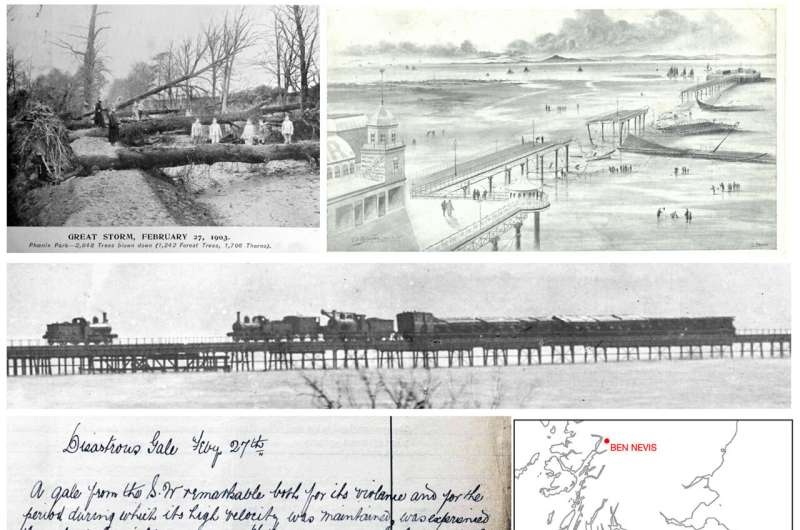This article has been reviewed according to Science X's editorial process and policies. Editors have highlighted the following attributes while ensuring the content's credibility:
fact-checked
trusted source
proofread
120-year-old storm's secrets could be key to judging weather risks

A severe windstorm that battered the U.K. more than a century ago produced some of the strongest winds that Britain has ever seen, a team of scientists have found after recovering old weather records.
Old weather measurements, first recorded on paper after Storm Ulysses hit the U.K. in February 1903, have shed new light on what was one of the most severe storms to have hit the British Isles.
By turning hand-written weather data into digital records, the research team has laid the way to better understand other historical storms, floods and heat waves. These observations from the past can help experts to understand the risks of extreme weather now and in the future.
Professor Ed Hawkins, a climate scientist at the University of Reading and the National Center for Atmospheric Science, led the research. He said, "We knew the storm we analyzed was a big one, but we didn't know our rescued data would show that it is among the top four storms for strongest winds across England and Wales.
"This study is a great example of how rescuing old paper records can help us to better understand storms from decades gone by. Unlocking these secrets from the past could transform our understanding of extreme weather and the risks they pose to us today."
Into the archives
Published in Natural Hazards and Earth System Sciences, the research indicates that many storms that occurred before 1950 are left unstudied as billions of pieces of data exist only on paper, stored in archives around the world.
But a team of scientists led by Professor Hawkins delved into the archives to convert hand-written observations relating to Storm Ulysses from paper to digital. The cyclone caused multiple deaths and heavily damaged infrastructure and ships when it passed across Ireland and the U.K. between 26 and 27 February 1903.
Using the new digital data, the research team was able to use techniques similar to modern weather forecasting to simulate the storm and accurately assess the strength of Storm Ulysses' winds. Comparisons with independent weather observations, such as rainfall data, as well as photographs and written accounts from 1903 that outlined the devastation caused by the cyclone, helped to provide credibility for the reconstruction.
The reanalysis is beneficial for understanding the risks of extreme weather events as it showed that the winds experienced in some locations during Storm Ulysses would be rarer than once in 100 years. Having information about such a rare event provides valuable insight into the potential extra damage a similar storm could cause now in the future.
The 1903 storm is named Storm Ulysses because the damage to thousands of trees in Dublin is mentioned in the novel Ulysses by James Joyce, the events of which are set the year after the storm.
Rescuing the weather
The rescuing of atmospheric observations related to Storm Ulysses is not the first time Professor Ed Hawkins has led weather record recovery. National rainfall data from as far back as 1836 became available in 2022 after the University's Department of Meteorology and 16,000 volunteers helped to restore 5.2 million observations.
The Rainfall Rescue project provided more context around recent changes in rainfall due to human-caused climate change.
More information: Ed Hawkins et al, Rescuing historical weather observations improves quantification of severe windstorm risks, Natural Hazards and Earth System Sciences (2023). DOI: 10.5194/nhess-23-1465-2023
Provided by University of Reading


















